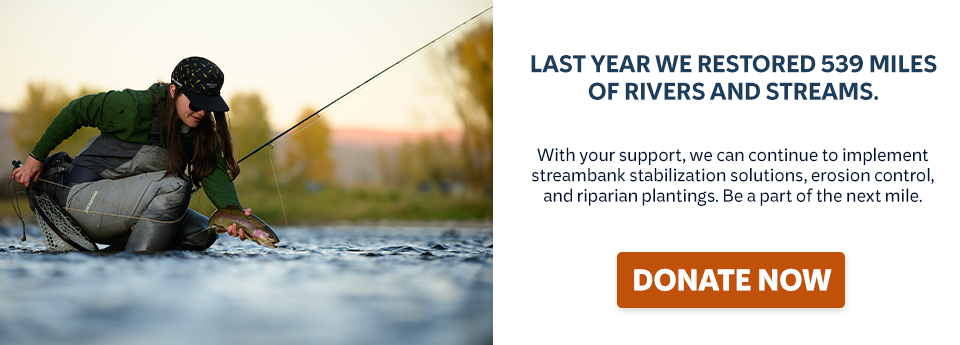Search results for “watershed”
FOR IMMEDIATE RELEASE CONTACT: Erin Mooney 703-284-9408 Howard Kern recognized for his work protecting Californias golden trout Arlington, VA.– Trout Unlimited (TU) volunteer Howard Kern, of Westlake Village, Calif., was named Field&Stream magazines 2009 Conservation Hero of the Year. Howard represents the best of TU’s members, said Chris Wood, TUs Chief Operating Officer. He is…
FOR IMMEDIATE RELEASE Contact: Kim Trotter, (208) 552-0891, x. 712 ktrotter@tu.org Bart Gamett, (208) 588-2224bgamett@fs.fed.us Trout Unlimited Idaho Project Receives Forest Service Award Trout Unlimiteds Idaho Water Project (IWP) recently received the 2009 national Rise to the Future Partner Award from the USDA Forest Service, which recognized IWPs leadership in restoring fish populations in the…
Contact: Keith Curley, (703) 284-9428 FOR IMMEDIATE RELEASE: Hits taken, but federal spending bill less damaging than first proposedSportsmen’s voices heard in Congress; cutting conservation programs would have been bad policy WASHINGTON – Congress apparently heard the outcry over deep proposed cuts to vital conservation programs from Trout Unlimited and other sportsmen’s conservation groups, as…
Contact: Steve Moyer, (703) 284-9406 Jim Klug, (406) 585-8667 FOR IMMEDIATE RELEASE: American Fly Fishing Trade Association Joins TU in Opposing Bill that would Trash Americas Backcountry AFFTA cites loss of habitat and opportunity that would impact the bottom line of the fly fishing industry WASHINGTON, D.C.The American Fly Fishing Trade Association today joined Trout…
FOR IMMEDIATE RELEASE: CONTACT: Erin Mooney, Trout Unlimited, 703-284-9408, emooney@tu.orgKaty Dunlap, Trout Unlimited, 607-742-3331, kdunlap@tu.org Trout Unlimited Calls on Pennsylvania Legislators to Take Immediate Action on Marcellus Shale Commission Recommendations Additional protections needed–legislators must address reports shortfalls. Arlington, Va.– Trout Unlimited (TU) supports many of the recommendations from the Pennsylvania Marcellus Shale Advisory Commission for…
Contact:Russ Schnitzer, (307) 438-1365Steve Moyer, (703) 284-9406 FOR IMMEDIATE RELEASE: Trout Unlimited Praises Senate Reauthorization of Farm Bill, Urges Swift House Passage Conservation Programs a Proven Investment in Nation’s Outdoor Heritage and Rural Communities Arlington, Va. Trout Unlimited today commended the U.S. Senate for voting to reauthorize the Farm Bill and ensure that its highly…
Nov. 18, 2014 Contact: Katy Dunlap, Trout Unlimited Eastern Water Project Director, 607-742-3331 Mark Taylor, Trout Unlimited Eastern Communications Director, 540-353-3556 FOR IMMEDIATE RELEASE Monongahela National Forest recognized in 10 special places report Rugged forest in West Virginia has attracted hunters and anglers for generations WASHINGTON, D.C.Trout Unlimited is featuring the Monongahela National Forest in…
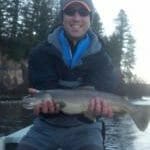
Elizabeth Maclin Feb. 23, 2015 Contact: Chris Wood, President and CEO, Trout Unlimited (703) 284-9403 FOR IMMEDIATE RELEASE: TU promotes Maclin to executive VP post; Curley promoted to VP for eastern conservation WASHINGTON, D.C.Trout Unlimited President and CEO Chris Wood announced today the promotion of Elizabeth Maclin to the organizations executive vice president position. Maclin…
Contact: Mark Taylor, Trout Unlimited Eastern Communications Director, 540-353-3556 FOR IMMEDIATE RELEASE Michigan angler Chuck Sams wins 10 Special Places Essay Contest Virginians Bo Painter and Matthew Reilly garner second and third places WASHINGTON, D.C. Chuck Sams is an engineer living within a days ride of all the great Michigan rivers. He attends trout camp…
July 2, 2015 Contact: Jack Williams, TU Senior Scientist, (541) 261-3960 Chris Hunt, TU National Communications Director (208) 406-9106 FOR IMMEDIATE RELEASE: Teen angler from New Jersey is first TroutBlitz winner New Jerserys Puchalski wins attractor fly series from FlyAssortments.com WASHINGTON, D.C.Alex Puchualski, an 18-year-old angler from East Rutherford, N.J., recorded 16 observations for Trout…
Senator Cantwells precedent-setting water and fisheries legislation passes Senate Energy and Natural Resources Committee CONTACT: Michael Garrity, American Rivers, 206-852-5583 Lisa Pelly, Trout Unlimited, 509-630-0467 Ben Greuel, The Wilderness Society, 360-670-2938 (Nov. 19, 2015) Seattle, Wash. Today federal legislation to protect and enhance the Yakima River basins fisheries, ecosystem and water supply was passed by…
July 6, 2016 For Immediate Release Contact: David Nickum, dnickum@tu.org, (720) 581-8589 Mely Whiting, mwhiting@tu.org, (720) 470-4758 Trout Unlimited praises river benefits, cooperation on Moffat Project As Denver Waters proposed project gains Gov. Hickenlooper endorsement DENVER Colorado Gov. John Hickenlooper today officially endorsed Denver Waters proposed Gross Reservoir Expansion Project, also called the Moffat Collection…

The Burns’ father-daughter team, Bianchi Flowers Farm, Pescadero Creek By Sam Davidson It’s common knowledge that most of Earth’s surface is covered with water. 71 percent of it, to be precise. In fact, all that water is what makes our planet the exceedingly rare biological gem that it is in the vast vault of our…
FOR IMMEDIATE RELEASE Nov. 17, 2016 Contact: Tyler Baskfield, 720-530-9896, tbaskfield@tu.org Randy Scholfield, TU communications, 720-375-3961, rscholfield@tu.org Trout Unlimited, sportsmen win victory on Thompson Divide BLMs final leasing plan offers protection for critical fish, wildlife habitat Denver, CO Trout Unlimited and sportsmen and women today praised the decision by the Bureau of Land Management (BLM)…
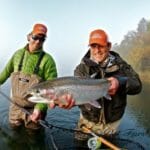
A New York investment firm has declared Northern Dynasty, the company that wants to dig Pebble Mine in Alaska, worthless. Pat Ford photo. It’s a good day to be a salmon or a trout in the Bristol Bay region of Alaska. Today, Kerrisdale Capital, a New York City investment firm, declared Northern Dynasty worthless. Northern…
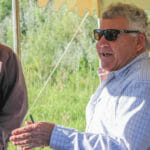
Mark Fowden retired ater 39 years with Wyoming Game and Fish in early January. He passed away March 31. Photo courtesy Wyoming game and Fish. By Cory Toye Wyoming lost a man who dedicated his life to the conservation and management of our great fisheries when Mark Fowden passed away March 31. Mark led a…

New drilling policies are a win for fish and wildlife. Now a key federal agency needs to modernize its oil and gas leasing rules.

Region: AlaskaActivities: FishingSpecies: Chum, Chinook, Sockeye, Pink and Coho salmon; Dolly Varden; Steelhead; Coastal cutthroat trout; Rainbow trout Where: The Tongass encompasses 17 million acres of public land, spread across much of Southeast Alaska. It’s a wonderland of hulking hemlock, spruce and cedar western hemlock, Sitka spruce, western red cedar and yellow cedar trees, dotted…

A few weeks ago, we introduced you to a radical drift boat design from Justin Gallen over at Raindog Boatworks. Today, we have an update.
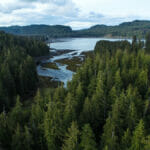
Roadless Rule restored on 9.3 million acres of the Tongass

